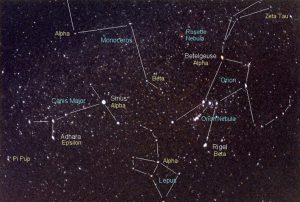If you go outside on a clear winter evening, the first star in the sky you will see emerging from the fading glow of the setting sun will be Sirius. Sirius is the brightest star in the entire night sky, with a magnitude that can rival that of some of the brightest planets visible in the night sky, such as Jupiter and Venus. To astronomers, Sirius is known as Alpha Canis Major, due to it being the brightest star in its home constellation of Canis Major, the greater dog (1). Sirius can be found by locating the constellation of Canis Major, which is visible in the winter in the northern hemisphere. It is close to the impressive constellation of Orion and sits below smaller constellation known as Canis Minor, the lesser dog.

Sirius is located at the head of the constellation of Canis Major in the northern hemisphere (Image: Cicerone Extra, 2017)
Basic astronomical facts:
- Sirius is actually a star system as a smaller white dwarf star (Sirius B) orbits around Sirius A (1)
- Sirius is 8.6 million light years away- a factor that contributes to its relative brightness, as this makes it one of the closest stars to Earth (1)
- Sirius is twice as massive as our sun, although when compared to other stars out there, this makes it similar in mass to our sun (1)
- Sirius is 240 million years old and is classed as a main sequence star, like the sun, which means it still fuses hydrogen atoms to form helium atoms at its core (1)
Observing Sirius
Sirius typically appears white in the sky, but can appear to flicker between red and purple, especially when low to the horizon. This is a result of the dust and turbulence in the Earth’s atmosphere, not due to the star itself (2).
Sirius has a magnitude of -1.44, lower than any other star visible to us from Earth (2). Magnitude is the way astronomers measure a star’s brightness, with the higher numbers representing stars of a fainter brightness, and therefore the lower the magnitude, the brighter the star (2). If you observe Sirius on a moonless night, then as long as no other planets such as Venus, Jupiter or Saturn are visible, then you will be looking at the brightest object in the night sky! Sirius B, the white dwarf orbiting Sirius A, is too faint to be seen with the naked eye, but could be picked up with a telescope, if you know where to look (2).
Sirius in history and mythology
Stars and constellations are much more than just patterns in the sky, they have stories to tell and tell us stories about ancient civilizations who observed them thousands of years ago. Sirius is commonly known as the dog-star and the constellation of Canis Major has been associated with dogs for thousands of years all over the world (3). This is likely to be due to Canis Major’s close proximity in the sky to the constellation of Orion, the hunter, and Taurus, the bull; as it appears that a man and his hunting dogs are chasing a bull across the night sky (3). Sirius has also been specifically associated with dogs, such as the Greeks seeing Sirius as Cerberus- the three-headed dog (3).
In Ancient Egypt, Sirius played an important part in Egyptian culture and religion, with temples being aligned towards this star. Sirius coincided with the summer solstice, as Sirius emerged from behind the sun during this time, making it visible in the hours before sunrise (3). The Egyptian calendar was modeled on this event, and the moment signaled the beginning of a new year (3).
As for me, Sirius is the signal for the beginning of a crisp and clear winter evening, perfect for an evening of stargazing. You could say that Sirius is the winter stargazers alarm clock- the signal for us to get outside, set up our telescopes, adjust our eyes and wait for the sky to darken just a little more.

You must be logged in to post a comment.